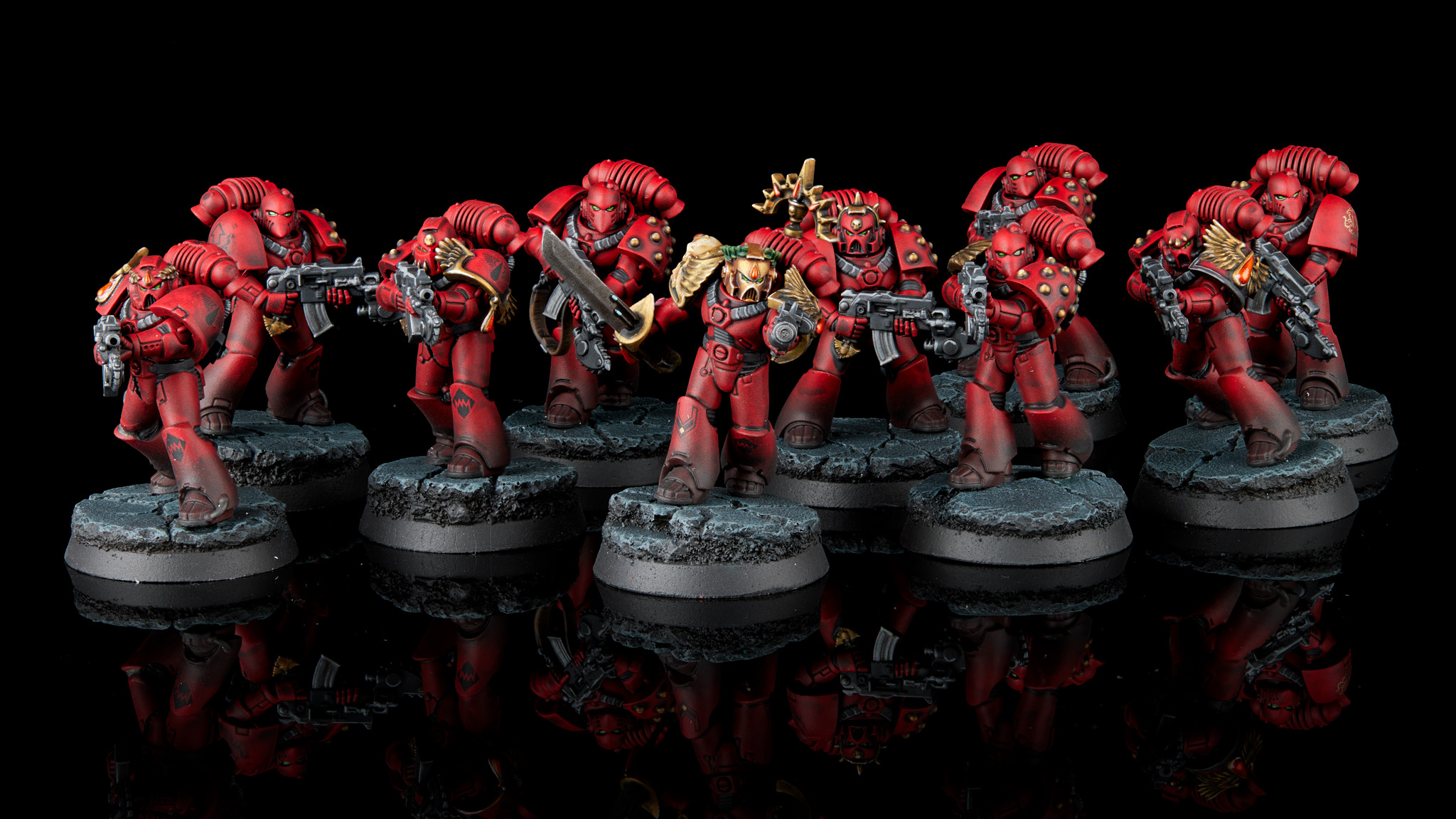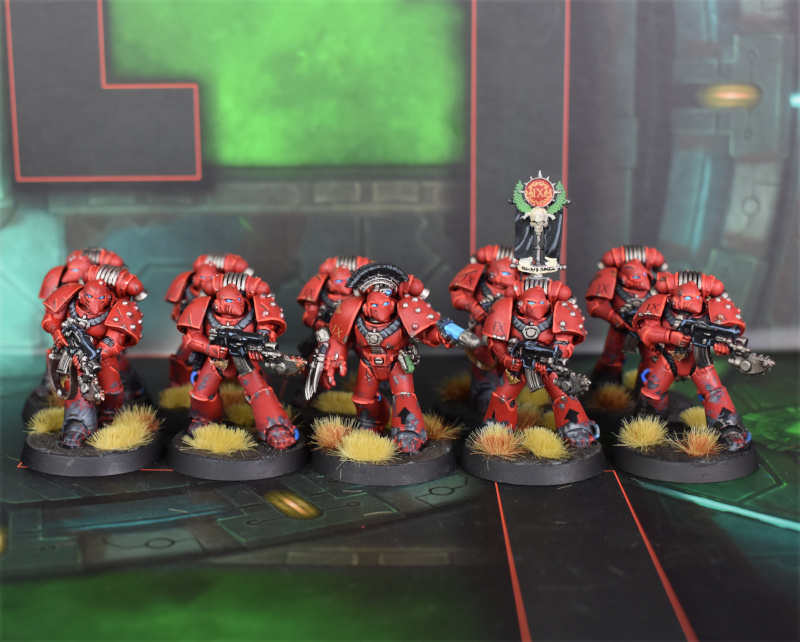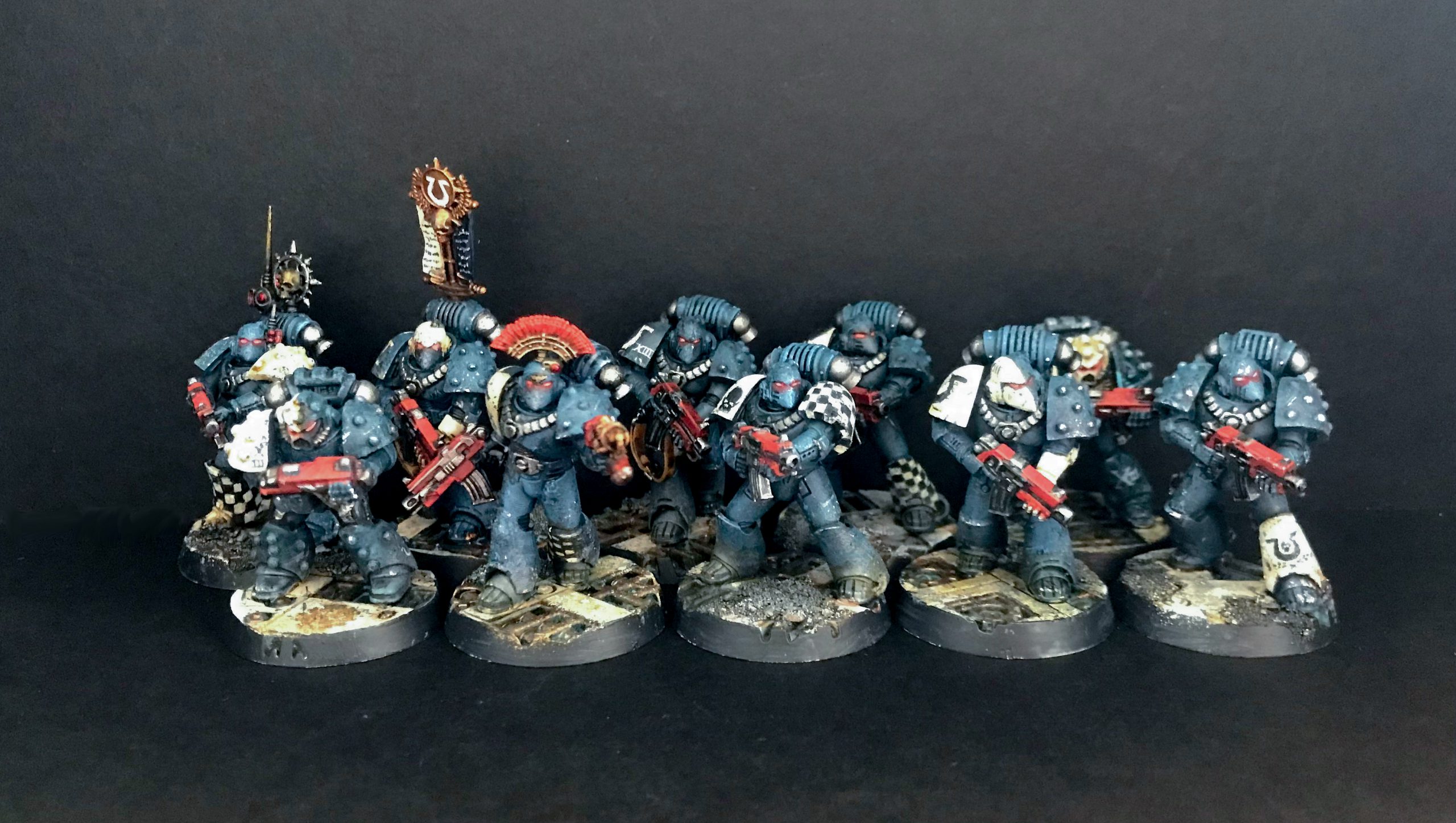Edit: I am a certified goober and stated that the Blood Angels Legion Trait was +1 to strength, when it actually is “requires one less to wound.” This doesn’t change the results within the testing parameters of this article, but it has been corrected.
Hi all! I’m Loxi; you might have seen me around the Magic section of Goonhammer before, but today I’m going to dive into some Heresy excitement. I need to give a bit of backstory to this before we jump in, but I want to give a disclaimer at first: Heresy is fundamentally a narrative and flavor-driven game. All of the suggestions and findings I am about to make are entirely moot if you just prefer something for one reason or another, so don’t necessarily build your army one way or another just based on raw data and min-maxed findings: Do what you want, this is mostly for a fun proof of concept.

I’ve been working on an army of Traitor Blood Angels (to ally with Death Guard and paint the town with Rad Grenades), and I had decided I wanted to run some Tactical squads for my compulsory troop slots. It had me thinking; what is the best choice of melee upgrade? I decided to dive into it more by doing some fun DiceMath(tm) and make some rough calculations on it, which led into just making an entire spreadsheet about this topic. My hypothesis is that the value of the different melee upgrades for tactical squads will vary depending on your choice of legion, and I set it out on an interesting adventure into the world of bayonets. If you want to Tally-Ho your tacticals into the heat of glorious melee combat, look no further.
If you don’t care about the nitty-gritty and just want to see results, feel free to skip down the the Analysis heading.
I’m choosing to formally set some testing variables as a way to keep everything consistent. Here’s the quick and dirty: 15 tacticals, on the charge, no effects from other units unless stated otherwise. The goal is to see what the combat effectiveness is of the unit as-is, and while you can totally just use supporting units and consuls to jack up the combat prowess of a unit, that somewhat defeats the use of tacticals. We’ll primarily look at the effectiveness vs. other Power Armored, WS4 marines, as more often than not this will be the primary target of tacticals. Against most things more powerful than that, your tacticals aren’t really going to be having a great time and are generally best suited for scrapping with other line troops. Against things weaker than that, they’ll likely chew through them pretty well regardless of what option you choose. We’ll use 15-marine strong units as a baseline. While I won’t say upgrades aren’t worthwhile on MSU squads, the effectiveness does increase the more models you add. In short, just roughly assume a 10-14 man unit will be slightly less efficient than shown, and a 16-20 man unit will be slightly more efficient due to there being more upgrades vs more default bodies. Of course, both of these come with a lower/higher opportunity cost for the unit respectively, so there are use cases for running a smaller unit with upgrades just to be cheap or fit in a transport. We’re going to look at charging numbers to give a better-case scenario for combat power, but I should mention up front that, depending on the specifics of your legion trait and the state of the board, tacticals might be best holding their ground and using reactions to pump shots into a charging unit, but that adds enough complexity that it might be worth investigating in a separate article. Lastly, we’re mostly assessing legion traits, but you may gain increased effectiveness from legion-specific Rites of War, which I’ll cover where applicable. There are a few other Rites that can potentially impact combat here, but I’m sticking with some of the more commonly applicable options. Also for the ease of math, we’re just assuming the unit leader has the same weapon as the unit, even though in a lot of these cases you might shell out a few more points for something better.
Now that you’ve all heard my blabbering, let’s get into the actual numbers.

Testing Parameters:
First, we’ll look at a control group for the experiment: I’m referring to this as “No Combat Buffs,” which is meant to apply to, well, any legion without melee bonuses. On top of that though, it also acts as a control group to use as a reference for how legions might scale up without their trait active for some reason. We’ll determine the average number of hits (vs. a WS4 target) and the number of wounds, before saves (vs. a Toughness 4 target), for each weapon upgrade. Lastly, the metric we’ll use primarily for this analysis will be what I refer to as the “Cost Effectiveness” of the upgrade. What this will determine is the amount of effective damage you’ll gain for taking the upgrade vs. the amount of points you spend on it. The calculation looks something like this:
(Average Wounds w/ Upgrade – Average Wounds with no melee weapon)/net cost of the upgrade for the unit
The point of this isn’t to analyze the cost effectiveness of the unit as a whole, but more to look at the increase in effectiveness with each tier of weapon. Speaking of which, we’ll go through the weapon upgrade options now if you’re unfamiliar with them.
Edit: It’s worth mentioning that the intent of this metric is to analyze the cost effectiveness of the upgrade over the base combat ability of zero upgrades, not the overall cost effectiveness of the model. We’re looking at how bayonets stack up against regular tactical marine attacks rather than just how efficiently the unit performs as a whole.
First up, we have the humble bayonet. For 1 point per model, you can pick up one of these glorified pieces of cutlery. The bayonet provides +1 Strength, but is Two Handed, meaning you won’t get any bonus attacks for wielding multiple weapons/having a pistol in addition to it, and you can’t use anything with it that requires a hand (like, for example, a Boarding Shield). In short, this doesn’t really impact tactical marines much, it just means you won’t get that +1A for multiple weapons.
Next on the chopping…er…stabbing block: the chain bayonet. If you like Gears of War and or/Home Depot, this will appeal to you greatly. The chain bayonet comes out at a cost of 2 points per model; double the whopping costs of a regular bayonet, but still quite an affordable option. These things will still give a nice +1 Strength and still be Two Handed like the regular bayonet, but also provide Shred, allowing you to re-roll all wound rolls with it.
Finally, we have an interesting pick to round out our choices: the revered chainsword. The chainsword doesn’t provide a Strength bonus, but it will give us Shred like the chain bayonet does. Most notably, however, is that the chainsword is NOT a Two Handed weapon, meaning we can claim that juicy bonus attack from having a pistol as well. The catch? These come in at 5 points per model, which can add some serious heft to the units total price when you start adding in more dudes.
Now that you know the hardware, I can show you the business:

If you want to look at some of the numbers yourself, feel free to check them out, but I’m going to dive right into a bit of mathhammer. Dice math for basic combat is actually pretty easy in a vacuum; just as an example, if you’re hitting on a 3+, it means a result of 1-2 is a miss, which just means two thirds of your attacks will hit (66.67%). I won’t get too detailed on this, as you can see much better explanations from our Hammer of Math series on the site if you want some more fleshed out mathmagical knowledge. To summarize, we can build some simple formulas to determine the average effective wounds a unit will deal based on knowing the stats of the attacker and the defending target.
For our “control” group of default legionnaires with no combat modifiers, we can assume that this unit of 15 brave charging souls with fists of fury will do about 7.75 wounds on average, before saving throws. It’s worth quickly noting for future reference that this comes from the following rolls:
To hit: 4+ (WS 4 vs WS 4), To Wound: 4+ (Str. 4 vs Toughness 4)
Nothing to write home about, but will take a few marines out in a pinch. This will be the baseline everything gets compared to: for 0 points of upgrades, this is what you’re working with. If you choose to embrace the call of Napoleonics that our Historicals team is howling from the front row and take regular bayonets, you’ll score about an extra 2.6 wounds thanks to that additional strength pip taking the wound roll up to a 3+. Chain bayonets really start to punch up here though, providing an extra 6 wounds over the ol’ sucker punches. Chainswords really blow the competition out of the water, giving a full 9.5 wounds over punches and a true demonstration of the power that a large volume of attacks has. How do these fair in terms of our cost-effectiveness rating? Chain Bayonets take the cake, with a 20% effectiveness per points rating over our base values. Regular bayonets fare decently well here too at 17.5% effectiveness, but chainswords and their heavy price tax only score just below a 13%.
So, how do other legions fare against this baseline? Let’s check it out:
Analysis:

As a quick reminder of the formula for cost effectiveness it’s as follows:
(Average Wounds Dealt with the upgrade – Average Wounds with no melee weapon)/Total Cost of Upgrades
Our first “category” of marines we’ll look at will be the strength modifiers: primarily, this means the Blood Angels get +1 to wound on the charge (well, “requires one less to wound,” but you get the idea) from Encarmine Fury, and the Night Lords with A Talent for Murder giving them a conditional +1 to wound if they target something they outnumber or something that’s pinned. Notably, this is +1 to the wound roll and not to the strength of the attack. This doesn’t really impact the math against other T4 targets, but it’s worth noting since it is usually more beneficial against some legions/targets.
But Loxi, aren’t you forgetting someone?
Quite literally, I did during my first iteration of this. Iron Warriors will get +1 Strength against dreads and vehicles. We’ll come back to this later, since right now I want to primarily focus on their value against other tacticals and generic line troops, but they do have a strength bonus. Woe is me.
It’s worth noting quickly the impact that the additional wound roll pip has on the rolls mentioned above. With no melee weapon, this takes us up to 10.4 wounds with fisticuffs, which is already notably more bite than marines that are afraid of hand to hand combat. Bayonets will take us up to a strength of 5 with +1 to wound; in the case of both Legions, a 2+ wound roll.
These guys are all a force to be reckoned with, as their actual combat effectiveness will increase significantly, but because they already punch pretty hard when they can use their legion trait, the value gained from melee weapons is technically lower, but that is a bit moot since they will be more useful when they can get in combat than non-combat legions. Where they get interesting is that bayonets will slightly edge out chain bayonets in cost effectiveness, even if only by slight margins. Where this becomes an issue is that Blood Angels will only pick up this on the first round of combat, so the second a combat stalls out you’ll be punching just like a regular marine again, and those chain bayonets might come in handy. Night Lords can hold up outnumbering for multiple turns, which can be nice if a combat gets a bit grindy.
Next, we’ll check out the hit/weapon skill options available. These primarily come from the Deathwing Hexagrammaton for the Dark Angels legion (which only applies to chainswords here) and the Logos Lectora for Ultramarines, providing the ability to use Retribution Strike, which will allow for +1 to WS and Charges at the cost of -1 BS. I cannot stress this enough: weapon skill is incredibly useful for combat with this rules set. While not considered in this specific hypothesis, WS also is a defensive tool (making it harder to hit you back) as well as an offensive tool that is generally harder to buff than the Strength of an attack, and the math here backs that up. The damage output from Retribution Strike is better across the board than a charge from Blood Angels with Encarmine Fury, which is pretty scary stuff.
The main reason for this is that you’ll get more effective value from Shred, since you’ll have both more dice to roll due to more hits as well as more re-rolls occurring. This means bayonets are only slightly better, but the chain weapons really can pack a bunch. This makes Deathwing Tacticals equally as scary with chainswords here, and their cost effectiveness is actually higher with chainswords than Ultramarines since they don’t get any native combat buff without one.
Lastly for our regular options, we have the lone World Eaters, packing the terrifying extra attacks. We can chuck all this math at you to show what effect the modified dice rolls have on a combat, but the math always choses the true winner over anything else: any problem is just solved with more dice. Having more attacks from the get go means these buffs will carry a lot more weight, and factor in the ability to replace your chainswords with chainaxes and you have a really terrifying flex-role unit.
Finally, we’ll check out Iron Warriors and how they fare against something that they might occasionally have to stare down in melee: the fabled Contemptor Dreadnaught. I’m throwing cost effectiveness out here since it’s really just these guys in contention: This is more of a curious case of “will these beat out krak grenades?”
The answer? Sometimes. Anything short of chainswords and you’re likely better off taking the beating and trying to sneak some Krak wounds through, but if you packed chainswords and can stick the charge, they actually will pack some punch and will let you actually hit at initiative. For what it’s worth, I would never bring them for this purpose, but if you find your bitter brethren bequeathed with blades and able to stick a charge, it’s likely better than waiting to eat the charge and throwing krak grenades.

Results and Conclusions:
For the sake of readability, I’m going to bullet highlight some key takeaways here:
- First and foremost, if your goal is Pure Combat Effectiveness and nothing more, chainswords will always be the best option. They are the most expensive for a reason, and provide the best choice for a flexible unit at the steepest price point.
- If your goal is Pure Cost Effectiveness for the Combat Power Gained, chain bayonets will almost always be the best choice due to the power increase over both regular attacks as well as bayonets at such a small cost.
- For Night Lords: A 20 man tactical squad with regular bayonets can be extremely cost efficient if you can maintain A Talent for Murder against your opponents. It’s dependent on the matchup, but against Marines, Talons, and Mech, this will be a solid unit.
- For Blood Angels: While the raw numbers from the test show that bayonets can still be an effective option, chain bayonets will still usually be worth it if you can spare the points as the change in efficiency is slim.
- For Dark Angels Deathwing Tacticals: Chainswords can make for a really solid unit if you want the flexibility over Despoilers, but I would run them in smaller units to avoid the cost sink.
- For Ultramarines in the Logos Lectora RoW: Take something, it doesn’t matter what, but if you plan to be anywhere but a backfield objective you can pack some serious bite against any non-dedicated melee units.
You don’t need me to tell you World Eaters are good with melee weapons.
- For Everyone Else:
The reality of this is that this is not a unit designed for melee, and will still only be as effective as a tactical squad can be, even with decent melee weapons. A lot of these options can help build out the core of your list, but many of these upgrades won’t break your game plan, since these are units meant to play objectives and hold the line – take the upgrades you have the points to spare for.

If you made it to the end of this, I appreciate you reading through this little passion project of mine! Please feel free to reach out with any suggestions if I missed anything or any other things you’d like to see covered. Until next time; stay sharp friends.
Thanks for reading! If you have any questions or comments feel free to drop us a note in the Comments below or email us at contact@goonhammer.com. That’s also the best way to suggest topics for future articles. And if you want regular updates in your inbox, subscribe to our newsletter.



You must be logged in to post a comment.